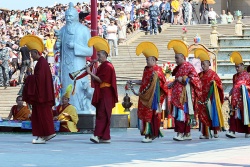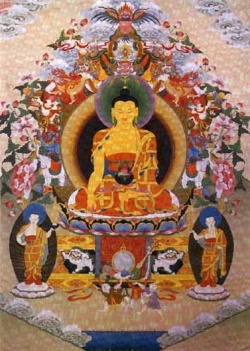Habits and routine of the Buddha
In the later Buddhist tradition and particularly in Mahāyāna, the Buddha came to be seen as a super-human being or even a god, who never did anything mundane and indeed never have to. However, in the Tipitaka, the earliest record we have of the Buddha, he is depicted as behaving like a normal person, which of course he was in many ways.
The Buddha's daily routine was very much what one would expect of a person in his position. He spent much of the day talking about the Dhamma to people who came to see him or guiding his monks and nuns. When visitors came he would ask his attendant to put his mat outside in the shade so he could sit and talk to them (D.I,152). At such times Ananda or another of his attendants would sometimes stand behind him fanning him to keep him cool (D.II,72; M.I,83). On one occasion he asked Ānanda to bring his mat so that he could go to the woods for an afternoon rest (D.II,102). The Buddha only eat once a day (M.I,437) and always before noon. Usually he went alms gathering to get his food but would also accept invitations to have a meal at someone's home. He would eat mindfully and then wash his hands and bowl when finished (M.II,138-9).
Again, like everyone else, the Buddha's body got dirty and had to be washed. We have a description of him standing on the bank of a river, dressed in his under cloth and drying himself after his bath (M.I,161). As is the custom in India even today, he probably bathed before eating. Sometimes he would have an afternoon siesta (M.I,250) although this was probably in his later life and only during the summer. When he was old he would sit warming his back in the late afternoon sun (S.V,216). Except when he was tired or ill, the Buddha always made time for the people who came to ask him questions or seek his advice. However, there were times when he just liked to be by himself for a while. When he decided to do this he would either tell his attendant that he was not to be disturbed (D.I,151) or tidy his room and then go off without informing anyone (S.III,95).
In the late afternoon the Buddha would sometimes 'do the rounds of the hospital' (gilānasālā) to comfort the patients or make sure everything was in order (A.III,142; S.IV,210; Vin.I,301). During the evenings he would walk up and down in the cool (D.III,80), perhaps meditating or just stretching his legs. There are many references to him giving talks that 'went far into the night' (D.II,86) either to groups of monks or to lay people. When appropriate, he would ask one of his more accomplished disciples to give a talk and then sit and listen. On one such occasion, his back was aching so he lay down while listening to the sermon (A.V,123-4). We have no information about how long the Buddha slept for but the Tipiṭaka mentions that he would often meditate all through the night (A.III,299).
In the process of living the Buddha did all the little things that other people do. For example, he would open the door of his hut to let a visitor in (D.I,89), wash his own feet before entering a building (D.II,85) and cough as he opened a door to let those inside know he was coming (M.I,161). There is an amusing incident recorded in the Vinaya which underlines both the Buddha's humanness and his common-sense attitude. Once while giving a talk he sneezed and everyone in the audience called out 'Live long!' (ciraṃ jīva!). This made so much noise that the talk was interrupted. The Buddha then asked the audience: 'When “Live long!” is said after someone sneezes, do they live long or not because of that?' The monks admitted that this was not so. The Buddha agreed and said that therefore it is not necessary to say “Live long!” each time someone sneezes (Vin.II,140).
People often associate enlightenment with being physically extraordinary and possessing super-normal powers. In traditional Buddhist countries it was widely believed that the Buddha was 5.4 meters tall and that he did not walk but flew from one place to another; that he never had to do anything for himself because gods and angels did it all for him and that it was unnecessary for him to bathe because his skin was so smooth that no dirt or dust adhered to it. Statues and pictures of the Buddha passing away inevitably depict him with the features of a young man, despite the fact that he was 80 when he died. The Buddha was extraordinary but not in the way people usually think and he did have amazing powers but not the miraculous type. The Buddha was extraordinary in that he was unfailingly kind, patient, courageous and serene. His power was that of a profound understanding into the nature of reality that freed him from the rounds of birth and death.
References
- Buddhism A to Z. Ven. Dhammika, 2007.
- http://sdhammika.blogspot.com/

